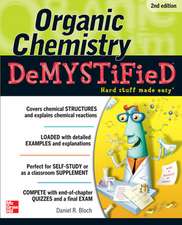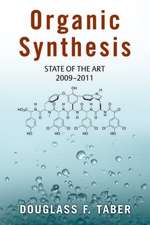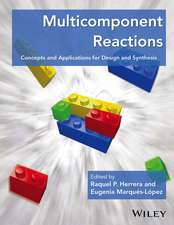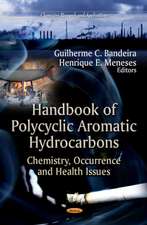The Art of Writing Reasonable Organic Reaction Mechanisms
Autor Robert B. Grossmanen Limba Engleză Paperback – 30 noi 2010
| Toate formatele și edițiile | Preț | Express |
|---|---|---|
| Paperback (2) | 394.46 lei 6-8 săpt. | |
| Springer International Publishing – 8 ian 2021 | 394.46 lei 6-8 săpt. | |
| Springer – 30 noi 2010 | 514.20 lei 38-44 zile | |
| Hardback (2) | 527.93 lei 6-8 săpt. | |
| Springer – 13 dec 2002 | 527.93 lei 6-8 săpt. | |
| Springer International Publishing – 5 dec 2019 | 532.61 lei 6-8 săpt. |
Preț: 514.20 lei
Nou
Puncte Express: 771
Preț estimativ în valută:
98.44€ • 101.24$ • 81.66£
98.44€ • 101.24$ • 81.66£
Carte tipărită la comandă
Livrare economică 15-21 februarie
Preluare comenzi: 021 569.72.76
Specificații
ISBN-13: 9781441930163
ISBN-10: 1441930167
Pagini: 372
Dimensiuni: 155 x 235 x 20 mm
Greutate: 1.15 kg
Ediția:Softcover reprint of the original 2nd ed. 2003
Editura: Springer
Colecția Springer
Locul publicării:New York, NY, United States
ISBN-10: 1441930167
Pagini: 372
Dimensiuni: 155 x 235 x 20 mm
Greutate: 1.15 kg
Ediția:Softcover reprint of the original 2nd ed. 2003
Editura: Springer
Colecția Springer
Locul publicării:New York, NY, United States
Public țintă
GraduateDescriere
Intended
for
students
of
intermediate
organic
chemistry,
this
text
shows
how
to
write
a
reasonable
mechanism
for
an
organic
chemical
transformation.
The
discussion
is
organized
by
types
of
mechanisms
and
the
conditions
under
which
the
reaction
is
executed,
rather
than
by
the
overall
reaction
as
is
the
case
in
most
textbooks.
The
treatment
emphasizes
unifying
principles,
showing
how
common
mechanisms
link
seemingly
disparate
reactions.
Each
chapter
discusses
common
mechanistic
pathways
and
suggests
practical
tips
for
drawing
them.
Worked
problems
are
included
in
the
discussion
of
each
mechanism,
and
"common
error
alerts"
are
scattered
throughout
the
text
to
warn
readers
about
pitfalls
and
misconceptions
that
bedevil
students.
Each
chapter
is
capped
by
a
large
problem
set.
The author has drawn on his own research and the current literature to ensure that appropriate attention is given to topics across the range of modern organic chemistry. The text is unique in its inclusion of a chapter on reactions mediated or catalyzed by transition metals, an area in which mechanistic understanding is now essential. Relatively new topics such as olefin metathesis and cycloaromatization are covered without giving short shrift to more traditional areas such as carbonyl chemistry. The text assumes a basic knowledge of organic chemistry. It can be used either in a formal course or by students working on their own, and will be particularly useful for graduate students studying for qualifying examinations. It will also be useful to students and researchers in biochemistry, pharmacology, and inorganic chemistry.
"This is an excellent and well-presented work.... The author ... has succeeded well in treating the central ideas of reactivity and selectivity in an integrated whole. The clear style of writing, the well chosen examples, and the ... concise summaries of the main points provided at the end of each chapter should enable the reader to easily consolidate what has been learned.... The book is indeed a little work of art."
-- Jens Hartung, Angewandte Chemie International Edition
"I have taught a one-credit course with this book for three years, and, uniformly, the students have rated this book highly for its clarity and for the scope of the problems. ... This book does an excellent job at its stated goal: 'to teach students to come up with reasonable mechanisms for reactions they have never seen before.'"
-- Amy Howell, Synthesis
"I have just finished my first year of graduate studies in organic chemistry at Duke University. I just wanted to let you know how much your book got me through the past year of course work.... When it came to mechanisms, I found the clarity and thoroughness I needed only in your book. It was impressive how you were able to present so much information in a clear and comprehensive manner yet keep the book so manageable in size. In addition to the text, I also was able to benefit from the problems.... Great practice!! The on-line answers are much better than looking up answers by reference.... I am reading it again this summer in preparation for my preliminary exam next spring."
-- David Gooden
The author has drawn on his own research and the current literature to ensure that appropriate attention is given to topics across the range of modern organic chemistry. The text is unique in its inclusion of a chapter on reactions mediated or catalyzed by transition metals, an area in which mechanistic understanding is now essential. Relatively new topics such as olefin metathesis and cycloaromatization are covered without giving short shrift to more traditional areas such as carbonyl chemistry. The text assumes a basic knowledge of organic chemistry. It can be used either in a formal course or by students working on their own, and will be particularly useful for graduate students studying for qualifying examinations. It will also be useful to students and researchers in biochemistry, pharmacology, and inorganic chemistry.
"This is an excellent and well-presented work.... The author ... has succeeded well in treating the central ideas of reactivity and selectivity in an integrated whole. The clear style of writing, the well chosen examples, and the ... concise summaries of the main points provided at the end of each chapter should enable the reader to easily consolidate what has been learned.... The book is indeed a little work of art."
-- Jens Hartung, Angewandte Chemie International Edition
"I have taught a one-credit course with this book for three years, and, uniformly, the students have rated this book highly for its clarity and for the scope of the problems. ... This book does an excellent job at its stated goal: 'to teach students to come up with reasonable mechanisms for reactions they have never seen before.'"
-- Amy Howell, Synthesis
"I have just finished my first year of graduate studies in organic chemistry at Duke University. I just wanted to let you know how much your book got me through the past year of course work.... When it came to mechanisms, I found the clarity and thoroughness I needed only in your book. It was impressive how you were able to present so much information in a clear and comprehensive manner yet keep the book so manageable in size. In addition to the text, I also was able to benefit from the problems.... Great practice!! The on-line answers are much better than looking up answers by reference.... I am reading it again this summer in preparation for my preliminary exam next spring."
-- David Gooden
Cuprins
1
The
Basics.
2
Polar
Reactions
under
Basic
Conditions.
3
Polar
Reactions
under
Acidic
Conditions.
4
Pericyclic
Reactions.
5
Free-Radical
Reactions.
6
Transition-Metal-Mediated
and
-Catalyzed
Reactions.
7
Mixed-Mechanism
Problems.
Recenzii
From
the
reviews
of
the
second
edition:
"… Grossman’s book differs from others in the scale of the worked examples. The number of problems incorporated into the text is extraordinary. The author provides the student a Web site that includes the detailed mechanisms for every problem in the book, each of which includes explanation and commentary, and the answer set, when printed, exceeds 250 pages! . . . In style,The Art of…is unique in that it does not read like a typical textbook. Instead, the feel is like that of having a personal tutor next to you walking you through the chemistry in a step-by-step fashion. The writing is clear, concise, engaging, and, at times, outright entertaining. The lively style includes "Common Error Alerts" that teach students what not to do and includes tips and advice on how to solve problems . . . The highest compliment a reviewer can give is to adopt the text that he reviews. The next advanced course I teach will useThe Art of Writing Reasonable Reaction Mechanismswith the goal that students will be able to posit a plausible mechanism for any new reaction that they encounter. To those of you who have taught traditional physical organic chemistry out of the classic texts, I ask you to consider trying something, well… completely different.The Art of Writing Reasonable Reaction Mechanismsmight just change the way you do things."
-Journal of Chemical Education
"The Art of Writing Reasonable Organic Reaction Mechanisms has an entirely different scope, dedicated to teaching the application of first principles to the construction of organic mechanisms. … The number of problems incorporated into the text is extraordinary. The author provides the student a Web site that includes the detailed mechanisms for every problem in the book … . The writing is clear, concise, engaging and, at times, outright entertaining. … All sections are expertly written, well organized and up-to-date." (R. W. Holman, Journal of Chemical Education, Vol. 80 (11), 2003)
"In principle, most mechanisms are derived from a basis set of fundamental steps. … Grossman has succeeded in explaining these fundamentals in detail in an easily accessible monograph. … Readers can reinforce their incipient skills with practical illustrations, and are challenged throughout with complicated examples. … the present text offers additional lucid explanations and ideal opportunities for practice. This work will thus be indispensable for students who are interested in mechanisms, or who wish to gain an additional perspective." (www.organische-chemie.ch, July, 2004)
"This text shows how to write a reasonable mechanism for an organic chemical transformation. … It can be used either in a formal course or by students working on their own, and will be particularly useful for graduate students studying for qualifying examinations. It will also be useful to students and researchers in biochemistry, pharmacology, and inorganic chemistry." (Chimie Nouvelle, Vol. 84 (21), 2003)
"Robert Grossman in his book attempts to familiarize the student with the awesome power of reaction mechanisms … . What makes this book special and praise-worthy is the clarity of its presentation of the subject matter. The text is lucid and sharp-edged throughout. The production quality of the book is first-class, too. Paper, printing and binding are excellent, the reproduction of the numerous formulae and reaction schemes is outstanding. … Full marks for this ‘survival guide’ to the ‘organic jungle’." (T. Lazar, Synthesis, Issue 17, 2003)
"The book entitled ‘The Art of Writing Reasonable Organic Reaction Mechanisms’ … shows how to write a reasonable mechanism for an organic chemical transformation. The discussion is organized by types of mechanisms and the conditions under which the reaction is executed, rather than by the overall reaction as is the case in most textbooks. … Each chapter is capped by a large problem set. … The book will be useful to students and researchers in intermediate organic chemistry, biochemistry, pharmacology, and inorganic chemistry." (Process - Magazin für Chemietechnik, Vol. 6 (3), 2003)
"Robert Grossman discusses ideas on organic chemical reactivity, selectivity and structure in a logical way that gives the student confidence in attempting the many practice problems provided. … This book provides a snapshot of examples of how to consider and approach the writing of simple and sophisticated examples of pushing electrons in and out of orbitals. Students will enormously benefit from using the principles and concepts in this book in writing their own mechanisms." (Helmut Hügel, Chemistry in Australia, 2003)
"… Grossman’s book differs from others in the scale of the worked examples. The number of problems incorporated into the text is extraordinary. The author provides the student a Web site that includes the detailed mechanisms for every problem in the book, each of which includes explanation and commentary, and the answer set, when printed, exceeds 250 pages! . . . In style,The Art of…is unique in that it does not read like a typical textbook. Instead, the feel is like that of having a personal tutor next to you walking you through the chemistry in a step-by-step fashion. The writing is clear, concise, engaging, and, at times, outright entertaining. The lively style includes "Common Error Alerts" that teach students what not to do and includes tips and advice on how to solve problems . . . The highest compliment a reviewer can give is to adopt the text that he reviews. The next advanced course I teach will useThe Art of Writing Reasonable Reaction Mechanismswith the goal that students will be able to posit a plausible mechanism for any new reaction that they encounter. To those of you who have taught traditional physical organic chemistry out of the classic texts, I ask you to consider trying something, well… completely different.The Art of Writing Reasonable Reaction Mechanismsmight just change the way you do things."
-Journal of Chemical Education
"The Art of Writing Reasonable Organic Reaction Mechanisms has an entirely different scope, dedicated to teaching the application of first principles to the construction of organic mechanisms. … The number of problems incorporated into the text is extraordinary. The author provides the student a Web site that includes the detailed mechanisms for every problem in the book … . The writing is clear, concise, engaging and, at times, outright entertaining. … All sections are expertly written, well organized and up-to-date." (R. W. Holman, Journal of Chemical Education, Vol. 80 (11), 2003)
"In principle, most mechanisms are derived from a basis set of fundamental steps. … Grossman has succeeded in explaining these fundamentals in detail in an easily accessible monograph. … Readers can reinforce their incipient skills with practical illustrations, and are challenged throughout with complicated examples. … the present text offers additional lucid explanations and ideal opportunities for practice. This work will thus be indispensable for students who are interested in mechanisms, or who wish to gain an additional perspective." (www.organische-chemie.ch, July, 2004)
"This text shows how to write a reasonable mechanism for an organic chemical transformation. … It can be used either in a formal course or by students working on their own, and will be particularly useful for graduate students studying for qualifying examinations. It will also be useful to students and researchers in biochemistry, pharmacology, and inorganic chemistry." (Chimie Nouvelle, Vol. 84 (21), 2003)
"Robert Grossman in his book attempts to familiarize the student with the awesome power of reaction mechanisms … . What makes this book special and praise-worthy is the clarity of its presentation of the subject matter. The text is lucid and sharp-edged throughout. The production quality of the book is first-class, too. Paper, printing and binding are excellent, the reproduction of the numerous formulae and reaction schemes is outstanding. … Full marks for this ‘survival guide’ to the ‘organic jungle’." (T. Lazar, Synthesis, Issue 17, 2003)
"The book entitled ‘The Art of Writing Reasonable Organic Reaction Mechanisms’ … shows how to write a reasonable mechanism for an organic chemical transformation. The discussion is organized by types of mechanisms and the conditions under which the reaction is executed, rather than by the overall reaction as is the case in most textbooks. … Each chapter is capped by a large problem set. … The book will be useful to students and researchers in intermediate organic chemistry, biochemistry, pharmacology, and inorganic chemistry." (Process - Magazin für Chemietechnik, Vol. 6 (3), 2003)
"Robert Grossman discusses ideas on organic chemical reactivity, selectivity and structure in a logical way that gives the student confidence in attempting the many practice problems provided. … This book provides a snapshot of examples of how to consider and approach the writing of simple and sophisticated examples of pushing electrons in and out of orbitals. Students will enormously benefit from using the principles and concepts in this book in writing their own mechanisms." (Helmut Hügel, Chemistry in Australia, 2003)
Caracteristici
Ideal
as
an
independent
study
guide
or
reference
to
organic
chemistry
Helps readers develop the ability to distinguish between diverse reactions
Includes common error alerts that warns of pitfalls and misconceptions
Begins with all the basics of the structure and stability of organic compounds
Includes extensive problem sets at the end of each chapter
Helps readers develop the ability to distinguish between diverse reactions
Includes common error alerts that warns of pitfalls and misconceptions
Begins with all the basics of the structure and stability of organic compounds
Includes extensive problem sets at the end of each chapter
Notă biografică
Robert B. Grossman earned his A.B. degree at Princeton University and his Ph.D. at MIT. He then moved from Cambridge, Massachusetts to Cambridge, England for his postdoctoral work. In 1994, he moved from the United Kingdom (UK) to the University of Kentucky (UK), where he has been ever since. At UK, Dr. Grossman maintains an active research program focused on synthetic methodology, target-directed synthesis, and biosynthesis. He is also the creator of ACE Organic, a Web-based organic chemistry homework program. Dr. Grossman has also served two terms as one of the two faculty representatives on the UK Board of Trustees.
Textul de pe ultima copertă
Intended for students of intermediate organic chemistry, this text shows how to write a reasonable mechanism for an organic chemical transformation. The discussion is organized by types of mechanisms and the conditions under which the reaction is executed, rather than by the overall reaction as is the case in most textbooks. The treatment emphasizes unifying principles, showing how common mechanisms link seemingly disparate reactions.
Each chapter discusses common mechanistic pathways and suggests practical tips for drawing them. Worked problems are included in the discussion of each mechanism, and “common error alerts” are scattered throughout the text to warn readers about pitfalls and misconceptions that bedevil students. Each chapter is capped by a large problem set.
The author has drawn on his own research and the current literature to ensure that appropriate attention is given to topics across the range of modern organic chemistry. The text is unique in its inclusion of a chapter on reactions mediated or catalyzed by transition metals, an area in which mechanistic understanding is now essential. More modern topics such as olefin metathesis and cycloaromatization are covered without giving short shrift to more traditional areas such as carbonyl chemistry. The text assumes a basic knowledge of organic chemistry. It can be used either in a formal course or by students working on their own, and will be particularly useful for graduate students studying for qualifying examinations. It will also be useful to students and researchers in biochemistry, pharmacology, and inorganic chemistry.
The third edition includes greater discussion of the reactions of biological cofactors such as thiamine and pyridoxal, and discussions of modern developments such as metal-catalyzed C–H activation reactions have been added. In terms of stylistic improvements, the author has introduced color into drawings to improve visual clarity and has improved the depictions of radical anions and radical chain reactions.
Each chapter discusses common mechanistic pathways and suggests practical tips for drawing them. Worked problems are included in the discussion of each mechanism, and “common error alerts” are scattered throughout the text to warn readers about pitfalls and misconceptions that bedevil students. Each chapter is capped by a large problem set.
The author has drawn on his own research and the current literature to ensure that appropriate attention is given to topics across the range of modern organic chemistry. The text is unique in its inclusion of a chapter on reactions mediated or catalyzed by transition metals, an area in which mechanistic understanding is now essential. More modern topics such as olefin metathesis and cycloaromatization are covered without giving short shrift to more traditional areas such as carbonyl chemistry. The text assumes a basic knowledge of organic chemistry. It can be used either in a formal course or by students working on their own, and will be particularly useful for graduate students studying for qualifying examinations. It will also be useful to students and researchers in biochemistry, pharmacology, and inorganic chemistry.
The third edition includes greater discussion of the reactions of biological cofactors such as thiamine and pyridoxal, and discussions of modern developments such as metal-catalyzed C–H activation reactions have been added. In terms of stylistic improvements, the author has introduced color into drawings to improve visual clarity and has improved the depictions of radical anions and radical chain reactions.













